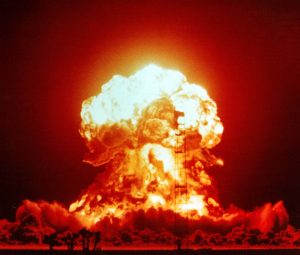India may be embarking on a covert uranium enrichment project aimed at producing thermonuclear weapons, a number of sources have recently speculated.
This week, Reuters reported that analysts at IHS Jane’s believe that the uranium enrichment facility at the Indian Rare Metals Plant is able to produce about twice as much weapons-grade uranium as New Delhi will need to fuel its nuclear powered ballistic missile submarines in the future.
“Taking into account all the enriched uranium likely to be needed by the Indian nuclear submarine fleet, there is likely to be a significant excess,” said Matthew Clements, editor of IHS Jane’s Intelligence Review, according to Reuters. “One potential use of this would be for the development of thermonuclear weapons.”
The report goes to explain that it has made this assessment based on new commercial satellite images of the Mysore-based facility in southern India. These images revealed a new uranium hexafluoride plant that would significantly increase the uranium enrichment capacity of the plant. Specifically, India would be able to produce about 160 kilos of uranium enriched to 90 percent levels, about double the amount it needs to power its submarine fleet. The plant is expected to become operational sometime next year.
The plant’s excess uranium—which is enough to make about five nuclear bombs—could be used to produce thermonuclear weapons. Reuters explains: “By blending the uranium with its existing stock of plutonium, India could develop thermonuclear weapons that have a more complex detonation process and greater force than simpler weapons.”
This assessment has been seconded by the Stockholm International Peace Research Institute (SIPRI). In a recent research brief, SIRPI noted, “A new unsafeguarded gas centrifuge facility appears to be under construction at the Rare Metals Plant near Mysore. India’s expanded centrifuge enrichment capacity has been motivated by plans to build new naval propulsion reactors, but the potential excess capacity could also signify its intent to move towards thermonuclear weapons by blending the current plutonium arsenal with uranium secondaries.”
China already has thermonuclear weapons and, given that India usually measures its strategic deterrent against China’s arsenal, this would likely be Delhi’s rationale for seeking a thermonuclear capability. Pakistan does not have any thermonuclear weapons, however, and Pakistan officials are already warning that India’s acquisition of them would lead to a nuclear arms race that Islamabad does not want.
Thermonuclear weapons have far more destructive power than nuclear bombs that rely solely on nuclear fission. As the Union of Concerned Scientists explain, thermonuclear weapons “derive their explosive energy from the combined power of nuclear fission and fusion. An initial fission reaction generates the high temperatures needed to trigger a secondary—and much more powerful—fusion reaction.” The yield on the first U.S. thermonuclear weapon was roughly 10 megatons or 10,000 kilotons.
India claims that the first device it detonated in its 1998 nuclear tests, Shakti I, was a two-stage thermonuclear weapon that ignited successfully and produced a forty-five kiloton yield (0.045 megaton), which was considerably below the two hundred kiloton yield expected. However, most foreign analysts believe this figure was highly inflated by India and many doubt that the thermonuclear device even successes ignited the second, fusion stage of the explosion. The view that the thermonuclear test failed is also held by former senior level Indian scientists.
As a result, if India does build more thermonuclear devices it could be tempted to conduct more nuclear tests to ensure their reliability.

































